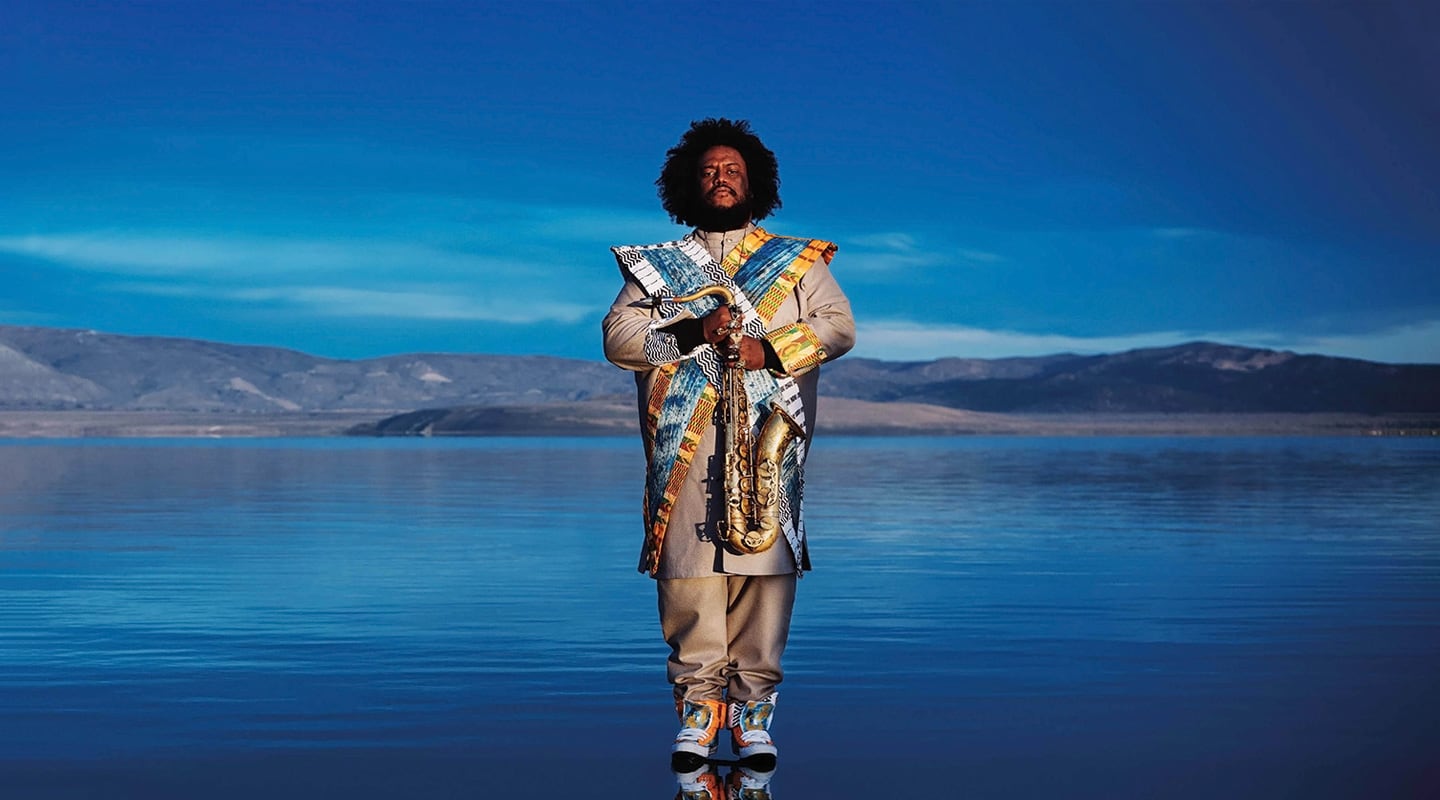
Jazz Saviour
Touring with Snoop at 18, breaking boundaries on Kendrick’s To Pimp A Butterfly, providing the groundwork for Flying Lotus’s albums. How Kamasi Washington and hip hop saved jazz.
Kamasi Washington doesn’t want to save jazz. He just wants you to give it a chance. In the same way that the perception of country music is saddled with layers of exaggerated twang, jazz has been pigeon-holed into the living rooms of audiophiles with squillion-dollar hi-fis, and quiet dinner-date background music. “Musicians in the past suffered from the word jazz having this bad reputation,” figured the saxophonist, who draws a lineage of jazz from early big band, through James Brown — “not the name, but the music, absolutely,” — to hip hop. “People putting words on jazz music and call it hip-hop. That’s been doing well,” he said. “Ask most R ’n’ B musicians and producers what they like, and they all love Herbie Hancock and Stevie Wonder. It’s jazz, the word, that’s been having a hard go of it, and it’s affected a lot of musicians who strongly associate themselves with that word. When people give the music a chance it’s such a freeing, spontaneous, soothing-to-your-soul music.”
Washington himself doesn’t like all jazz: “If you get introduced to John Coltrane, you’re not automatically going to like Count Basie. Same thing with hip-hop; you hear Kendrick and love it, but you may not like a DJ Luke song. I don’t know that my music can all of a sudden make people like jazz, what I hope it does is make people more open-minded so when they come across something labelled as jazz, they’re no longer saying, ‘I’m not listening to that!’ That’s what happened to jazz for a long time.”
Washington has lived on this bridge spanning jazz and hip hop for his entire career. “Hip hop was there as an option for me before jazz was,” said Washington, whose first tour after graduating high school was with Snoop. “I would go on tour with Snoop and come home and we’d have our own gig at 5th Street Dick’s, playing with people like Gerald Wilson,” said Washington. “Integration between jazz and hip hop was always there. I grew up in an area called Leimert Park, in Los Angeles. There was the World Stage, which was Billy Higgins’s jazz club, as well as 5th Street Dick’s, and around the corner was Project Blowed, where Freestyle Fellowship, Pharcyde and all those guys hung out. We would play Low End Theory which is a straight-up DJ club. There’d be four DJs, then an eight-piece band on a little, itty-bitty stage that could barely fit the DJ. The drummers had to play with a two-piece drumset, and share a crash cymbal! The people loved it. Jazz can exist in the same places all other music does.”
While the decades old confluence of jazz and hip hop was obvious to Washington, it really gained mainstream attention when Kendrick Lamar dropped the genre-hopping smash hit, To Pimp A Butterfly, to which Washington, and childhood friend and bassist Thundercat (Stephen Lee Bruner), contributed heavily. “Kendrick put it in the foreground, but people like Dre and Battlecat and cats like J. Dilla and Q-Tip, and A Tribe Called Quest, they were all using jazz,” said Washington. “Snoop’s whole band were jazz musicians, so they’ve always been in hip hop, just more behind the scenes. It just wasn’t really talked about, because hip-hop was so new, the story was about the new music more so than the music it integrated.”
While Washington knows the fight to reclaim jazz is an uphill battle, he’s comfortable carrying that weight on the shoulders of his dashiki. The opening track on his 17-song debut album, The Epic is literally called Change of the Guard, about a real dream he had of a young warrior rising to battle an established ageing guard. You can’t get more overt.
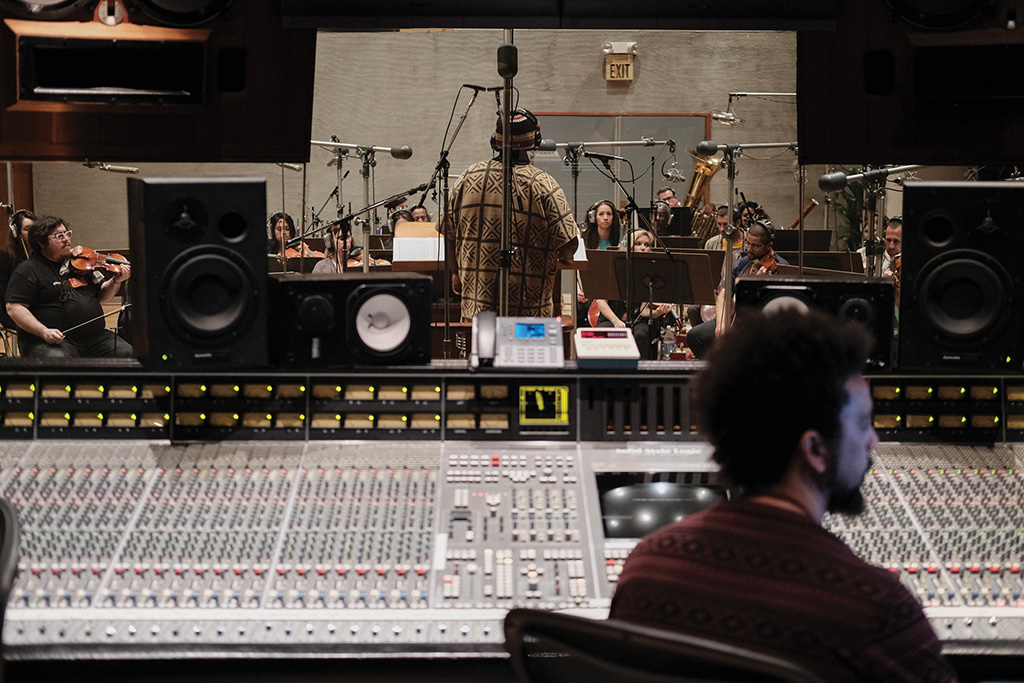
Washington writes and conducts all his orchestral arrangements, recorded at Henson with renowned mixing engineer, Russell Elevado, in the foreground.
RECORDING FIRST ALBUMS
Washington still lives in Inglewood — one of the suburbs on the doorstep of LAX — in his father’s house. Rickey Washington was a successful woodwind player in his own right, but chucked it in to break a cycle of fatherlessness and help raise Kamasi. He now travels on many of Kamasi’s tours and guests on the occasional song. Out the back of their house, Kamasi still has his garage studio where he first began recording.
“Pops is not into technology — we had to teach him how to text message — but he was always cool to let me have my space there. He likes having us around all the time, and that energy. My studio was definitely lo-fi back in the day. I had like a Digi 002, Behringer mic pres and copies of Neumann mics, but it had a vibe. It was called The Shack.
“I started off making beats with just an MPC and a Yamaha Motif keyboard. Then I got some advice from Tony Austin — my drummer and a really great engineer — and Terrace Martin, who had his own studio, about what I needed to record a full song.
“I bought some mics, then I bought the computer, and a lightpipe extender so I had 16 in. We’d all be in the same room — piano and drums in there. The L-shaped room provided a natural divide, and I bought some individual dividers to help the quieter instruments. It was still pretty tight; you could definitely hear everything in every mic, but there was a vibe to it and it was cool because we could use it whenever we wanted.”
THUNDERCAT’S AWAY
The biggest hit to come out of Washington’s backyard was Thundercat’s breakthrough album, The Golden Age of Apocalypse. He released it on Flying Lotus’s [Steven Ellison] Brainfeeder label, another good friend of the pair. It was the first of many albums to come out of their local tribe of musicians, some of whom are in Washington’s band, The Next Step. “We had been talking about it for years, that we had a sound,” said Washington. “When Thundercat came out with The Golden Age of Apocalypse it cemented the idea that we had something special. We would all be on different tours, but when we were in town we would make sure to come together and play. Even if it was to no-one, for no money. We didn’t care because we found this sound and approach that was different than what was going on in the rest of music.
“We each had our own version of this sound. When Thundercat’s album did so well, we thought we should all buckle down and record, but we were all working! I made up my mind that I was going to record, which was when Lotus asked if I wanted to make a record for Brainfeeder.”
Washington knew he wanted to record his own version of jazz, but his studio was “pretty limited. When you’re working in your own studio, you’re the engineer. Even when you hire an engineer, when something goes wrong and breaks, everyone is eventually going to look at you to fix it. It’s not the most creatively conducive environment to record. That’s when we decided to go to a different studio.”
He hatched a plan. Studio day rates can be fairly cost prohibitive for an independent musician looking to record an album, but they will generally do a deal on a longer term. Washington figured if he could get a few of the crew together that also wanted to record their own album, they could split the cost of a month’s hire and it would work out cheaper for everyone.
“If all eight of us pitched in and bought the days we needed for all of us, we’d get it at a much cheaper price than if we did it individually,” said Washington. “Plus, we’d get the benefit of being there with each other.” They found a studio, King Size Soundlabs in Los Angeles (home of Rob Schnapf’s MANT Studios), which had an “old Neve board, a pretty good mic cabinet, and some great instruments like a B3 organ, some cool synths, old Rhodes and Clavs. It was kind of ’70s and real old school. It was definitely not known for jazz, more like indie rock.”
It was a like a musical sweatshop with a rotating boss. You’d change project and the next person comes in full steam ahead!
SWINGIN’ SWEATSHOP
They devised a schedule, sometimes setting aside a complete day for one project, other times switching between a couple in a single day. “Each of us got maybe three full days, and everyone was supposed to be there the whole time every day,” said Washington. “It was a like a musical sweatshop with a rotating boss. You’d change project and the next person comes in full steam ahead! ‘Alright, let’s do it! Here we go!’”
Everyone approached their session differently, according to the sound they were trying to capture. Some recorded live, some overdubbed, some completely improvised, others wrote out charts. Washington goes both ways; charting out the tunes, with an ‘anything goes’ view of the actual recording.
“My songs are unorthodox so I have to explain what’s going on and build a chart,” he said. “I was trying to think of the players and what I could get out of them for each song. If I had a full day I would pick four songs, if it was a couple of hours I would pick one or two songs. I’d give it to the musicians and sit with them individually, and go over the kinds of things they could do and the kinds of places they could go.
“Then when we record, everyone knows I’m wide open. At the end you can do whatever you want to do with my music. If it’s cool, it’s cool. I’ll just go with the flow. If a song that was supposed to be a ballad starts getting played fast, Imma just go with it. Other guys would come in with an idea or rhythm and just jam it out. Music takes these weird twists and turns and my thought process was to record as many songs as I could and then try to find the album within that.”
Because he had everything written out, Washington managed to get the most songs recorded of anyone, about 45 in all. Out of that he picked 17, which became his first album The Epic.
It would be natural to assume that with so many changeovers, they’d stick with one recording setup that adequately served everyone. They weren’t going for adequate though. Each artist was trying to execute their specific vision, so the setup would be altered to match. To handle the changeovers, they went down to the Hollywood Musicians Institute and grabbed a bunch of interns to help wrangle leads, instruments and mics. “Tony Austin was running the sessions,” said Washington. “Everyone’s approach to the recording setup was different — in one scenario the bass might go through the Ampex, in another scenario I get it — so we had the interns moving gear around and re-patching every session. My approach was to have everyone playing at the same time, so my setup of the room was chock full. Only the orchestra and choir would be overdubbed later on, whereas others overdubbed everything.
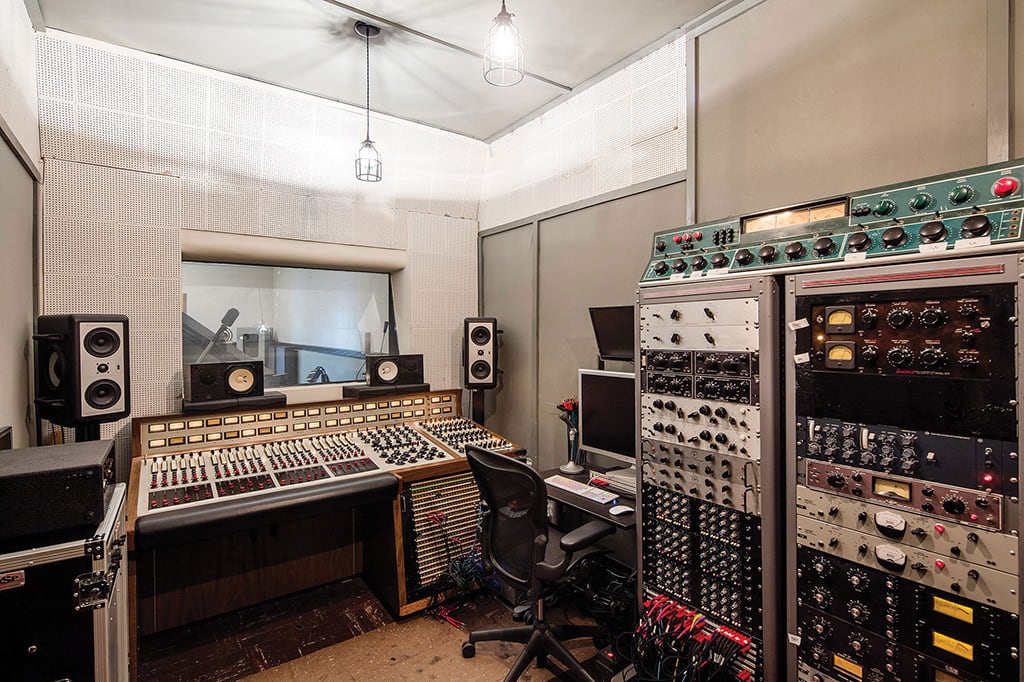
Vox Recording Studios is Washington’s dream studio. From the custom Deledio console built with a collection of vintage Universal Audio and API modules, to the floor-to-ceiling racks of Ampex tube preamps.
BIGGER THAN A CALIFORNIA KING
King Size Soundlabs is an amazing studio, but for his Harmony of Difference EP, Washington found a new favourite joint, Vox Recording Studios. Washington described it as “like King Size Sound on steroids.” Vox was the famed Electrovox studios, where the Wrecking Crew stationed themselves for a time, and jazz luminaries like Charlie Parker and Dizzy Gillespie recorded. It went out of business right around the time composer and guitarist Woody Jackson came into a pot of gold from scoring Grand Theft Auto V. “He used to work at a store called Black Market Music which was the best analogue recording equipment store in L.A,” recalled Washington. “He made a bunch of money scoring Grand Theft Auto and basically bought out Black Market Music.”
There’s an entire storage area full of vintage equipment, with racks of synths — “every Moog and two vinyl-based Mellotrons, which I’d never seen” [Jackson used to be a Mellotron technician – Ed] — rows of amps, and walls of drums and guitars. It’s a musician’s paradise, “like a kid in a candy store,” said Washington. On the engineering side, there’s an incredible array of analogue gear. At its core is a custom Deledio Console, built for Wally Heider, that has 24 channels with Universal Audio 1108 preamps, Universal Audio EQs, and API EQs on each. It was used on the Beach Boys’ Smile sessions. There’s also a Neve 5442 suitcase, and Neumann 18×4 console from Sunset Sound lying around. On the outboard side are all variety of Urei compressors, two Neve 2254e compressors, and a Fairchild 670. Pultec, Lang and Universal Audio EQs are also in the racks, flanked by a stack of Ampex 351 preamps and tape machines. Washington has a particular affinity for old Ampex tape machines, and not having to choose which channels to send through the old tape was a huge selling point for him: “Most studios have one or two. He has like 30 of them.” He then recorded the strings at Henson, which “doesn’t have some of the custom stuff but the room is so beautiful,” said Washington. “Then I got infamous mixing engineer, Russell Elevado [D’Angelo’s mixing engineer – Ed]. He shipped a bunch of his gear over from New York to Henson, and just brought a whole other level to it.”
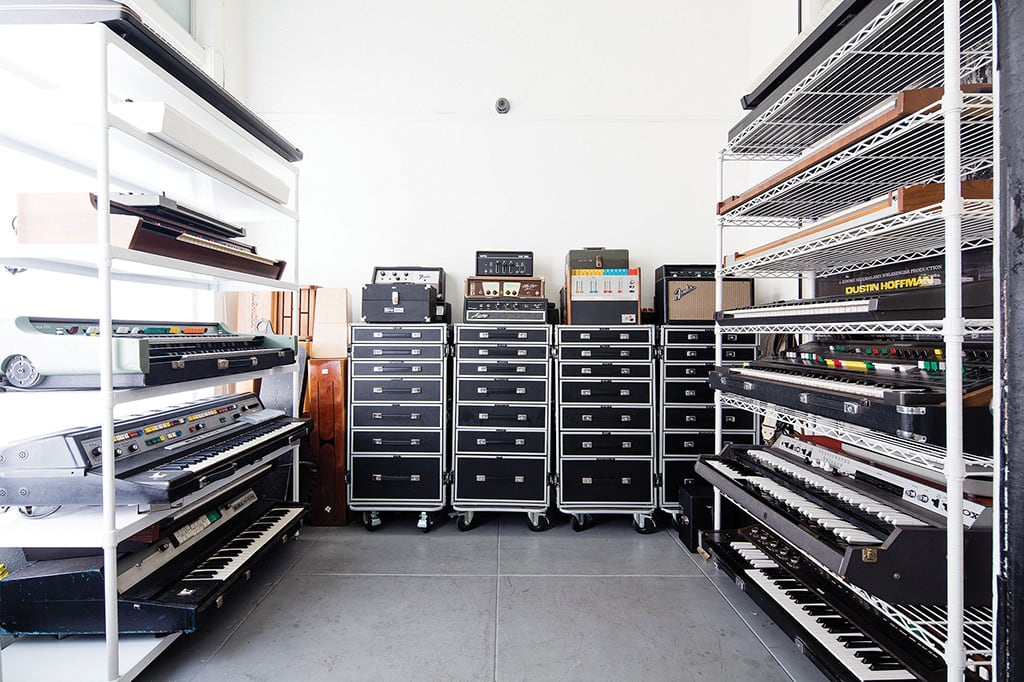
The instrument collection at Vox is staggering. These keyboard racks barely scratch the surface of what’s on offer, and all those drawers are full of pedals.
MODERN SEPARATION
For Washington, going to the trouble of finding a place stocked with vintage gear is not about emulating the hey-day of jazz. “It’s beyond jazz. The heyday of recorded music was the time just before we went digital,” said Washington. “There’s a warmth and a natural feeling that happens with analogue that you seem to lose as you use more digital components. On the flipside, there’s a clarity you get with digital that’s cool. I try to mix it up. To me, it’s all about what sounds the best. I’m not too philosophical with it. Even though we recorded to Pro Tools, we always mixed down to 1/2-inch tape. Russ, who mixed the last two records [including Washington’s latest Heaven & Earth], didn’t use any plug-ins, it was all analogue. Old mics and old pres with natural reverb. We mixed it at Henson and they had six different natural plate reverbs and four echo chambers. We were keeping it out of the box as much as possible.”
Kamasi doesn’t really have a template for the kind of music they’re recording, so it’s all about what sounds good to his ears. “A lot of the records I use as references aren’t jazz; like Beatles records, and King Crimson records,” said Washington. “To me it’s more about finding the character of the song than trying to make it sound like a classic jazz record. I try to take it from scratch because there’s no real good reference for a lot of stuff we’re doing. There’s no record that also has two drummers and two percussionists and upright bass, a whole load of keyboards, a grand piano and a whole orchestra — strings, winds, brass and a big choir. All playing intensely. There are jazz records that have orchestras, but it’s usually alongside a small jazz band playing softly.
“When I look at the pictures of how old records were made, by comparison we play with much more separation. We had each of the drummers in their own room. The horns, bass and piano were all in the same room, but it was big, so they were spread out. We used a lot of pedals and effects, we were re-amping things. We weren’t on a quest to emulate the sound of anything. It was more like, ‘What’s the sound of us?’”





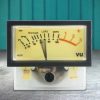










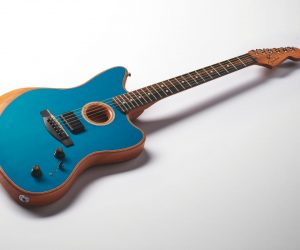











RESPONSES